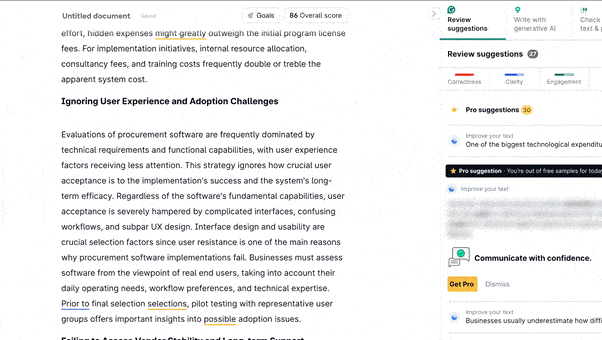One of the biggest technological expenditures businesses make to update their purchasing processes is choosing the appropriate procurement software. However, there are several possible pitfalls on the way to effective implementation that might turn attractive digital projects into expensive failures. Many companies approach the process of choosing procurement software with a lack of clarity on their needs, irrational expectations, or inadequate readiness for the next organizational changes. The most frequent mistakes that firms make when choosing procurement software are represented by the eight significant flaws listed below. Long-term user satisfaction and effective deployment are far more likely when these dangers are avoided.
1. Rushing Through Requirements Analysis Without Stakeholder Input
Businesses usually underestimate how difficult it is to collect thorough criteria for choosing procurement software. The need to speed up the review process frequently results in cursory analysis that ignores important operational details and user requirements. Stakeholder consultation is usually minimal in this hurried approach, which prioritizes clear functional requirements above process complexity and integration requirements. A wide range of stakeholders, including purchasing teams, finance departments, legal counsel, and end users at various organizational levels, must have substantial input for the selection of procurement software to be successful. Every group contributes distinct viewpoints about the operational limitations, intended functionality, and present difficulties that need to be taken into account. Insufficient requirements collection raises the possibility of choosing software that doesn’t meet genuine company demands and sets up irrational expectations.
2. Overlooking Integration Capabilities with Current Systems
While ignoring the need for integration with current business systems, many firms place a great deal of emphasis on the characteristics of independent procurement software. When the chosen software is unable to interface with accounting systems, inventory management tools, or enterprise resource planning platforms, this mistake leads to serious implementation issues. Poor integration often forces the use of manual data input, repeated record-keeping, complicated workaround procedures, and negates the benefit of productivity. The complexity of modern technology ecosystems of companies means that the procurement software should be capable of interfacing with numerous systems and data sources with ease. By the early phase of the decision-making, organizations must estimate the integration capabilities with the considerations of the future technological roadmaps and the current system requirements.
3. Underestimating Total Cost of Ownership and Hidden Expenses
Choosing software for procurement frequently prioritizes the initial license fees over the overall cost of ownership for the duration of the system’s operation. Implementation costs, training costs, continuing maintenance fees, and other modification requirements are not taken into consideration by this limited cost perspective. After a contract is signed, organizations usually find unanticipated charges, such as premium support services, additional user licenses, and data transfer costs. Particularly for complicated systems involving a great deal of integration or modification effort, hidden expenses might greatly outweigh the initial program license fees. For implementation initiatives, internal resource allocation, consultancy fees, and training costs frequently double or treble the apparent system cost.
4. Ignoring User Experience and Adoption Challenges
Assessments of procurement software often focus on technical needs and business features, although they do not give enough importance to user experience aspects. This plan overlooks the criticality of user acceptance towards the successful implementation of the project and the overall effectiveness of the system. Even without the essential functioning of the software, complex interfaces, abstract workflow, and poor UX design seriously impair user adoption. Interface design and usability are crucial selection factors since user resistance is one of the main reasons why procurement software implementations fail. Businesses must assess software from the viewpoint of real end users, taking into account their daily operating needs, workflow preferences, and technical expertise. Prior to final selection, pilot testing with representative user groups offers important insights into possible adoption issues.
5. Failing to Assess Vendor Stability and Long-term Support
A long-term technological investment, procurement software needs constant feature development, frequent upgrades, and vendor support. Sometimes, organizations choose solutions from businesses with erratic financial standing or little experience in the procurement software industry because they value instant functionality above vendor consistency. This strategy exposes a company to tremendous hazards in case the suppliers hit poor financial times, cease to produce goods, or fail to provide adequate ongoing support. An in-depth assessment of the financial well-being of the company, its standing in the market, customer satisfaction ratings, as well as long-term development plans should form part of the vendor evaluation. Current customer reference checks can tell you about the commitment of a vendor to product development, the level of support, and responsiveness.
6. Neglecting Security and Compliance Requirements
Strategic business intelligence, vendor data, and sensitive financial data are handled by procurement software, which needs strong security protection and adherence to applicable laws. Sometimes, when choosing an auction software, organizations prioritize usefulness above security, presuming that all solutions have sufficient security features. Due to the serious risks this strategy introduces, firms may be vulnerable to data breaches, legal infractions, and theft of competitive intelligence. Data encryption, access restrictions, audit trails, and adherence to industry-specific requirements must all be thoroughly evaluated as part of a security examination. Data management, vendor verification, and transaction documentation are further criteria for businesses in regulated sectors that the chosen software must meet. Particular consideration must be given to data residency, backup protocols, and disaster recovery capabilities when using cloud-based systems.
7. Choosing Solutions Based Solely on Price Considerations
In other cases, budget-minded companies end up with procurement or auction software mainly because of the price of the license, but they have not really focused on the utility or value and long-term plans. This short-term money-saving solution often comes back to bite the company in the future as pound-wise solutions often cost it far more in the end, both in operational restrictions and in unexpected costs. The low-cost systems often lack sufficient scalability, integration, and feature sets that may require expensive replacements or upgrades of systems. Procurement software should be selected on the basis of a value-based evaluation considering both cost factors and functionality, reliability, support quality, and strategy fit. The lowest-cost solution does not usually have the maximum long-term usefulness when opportunity costs, as well as productivity implications and total cost of ownership, are considered.
Conclusion
The choice of procurement or auction software is a crucial one that has a big influence on cost control, organizational effectiveness, and strategic capabilities. The intricacy of this decision-making process and the significance of thorough evaluation techniques that take organizational and technological aspects into account are highlighted by the eight typical mistakes listed in this guide.




